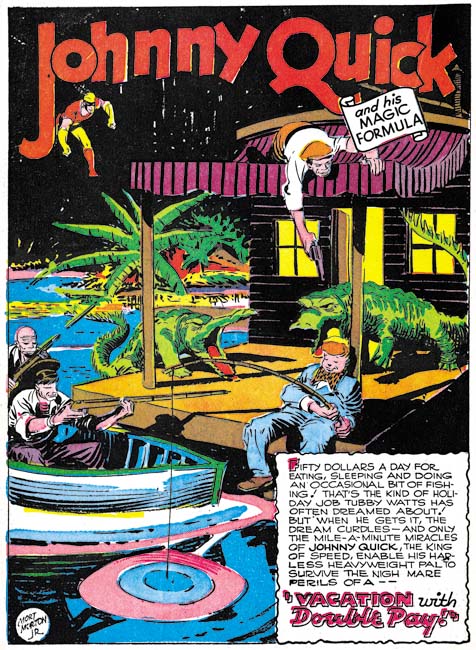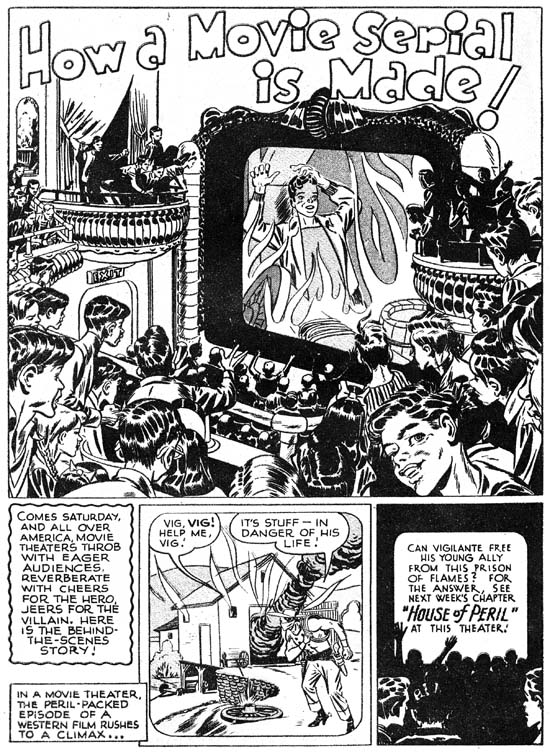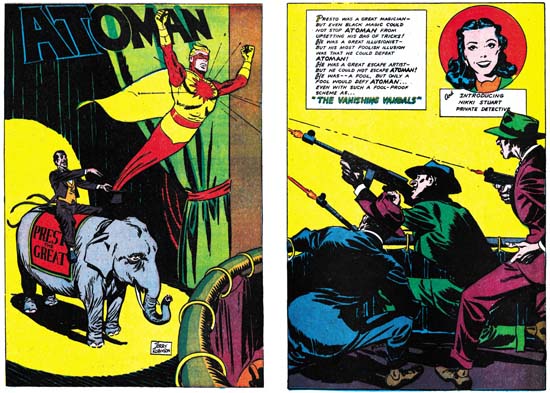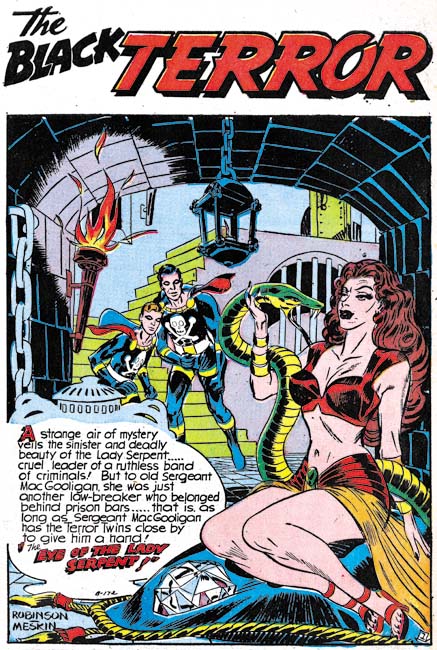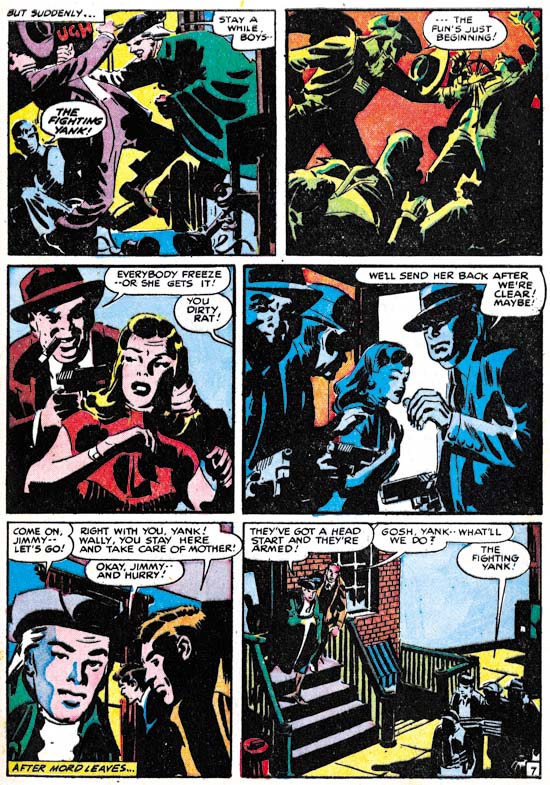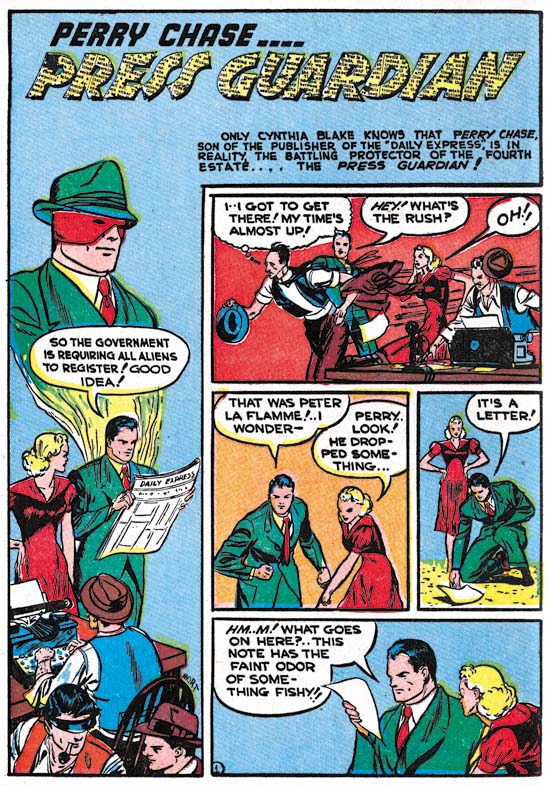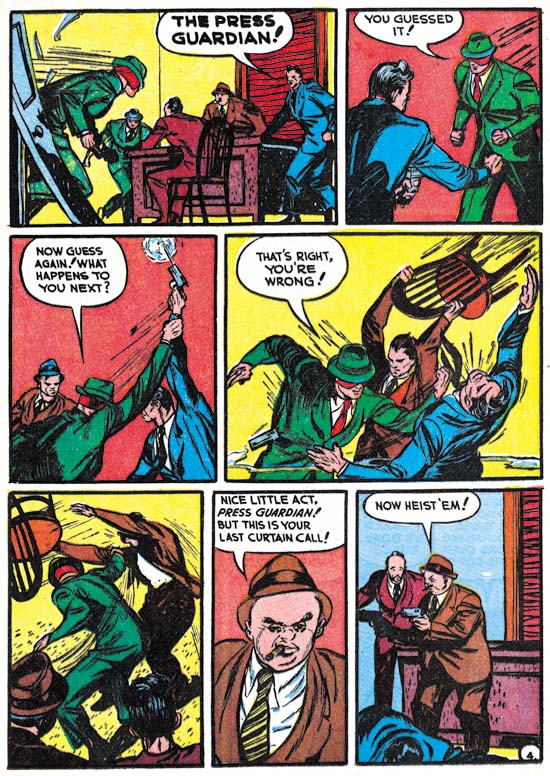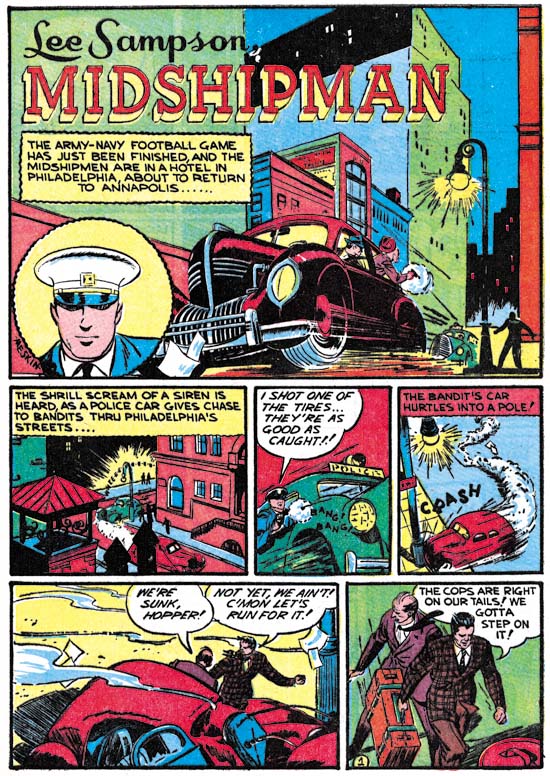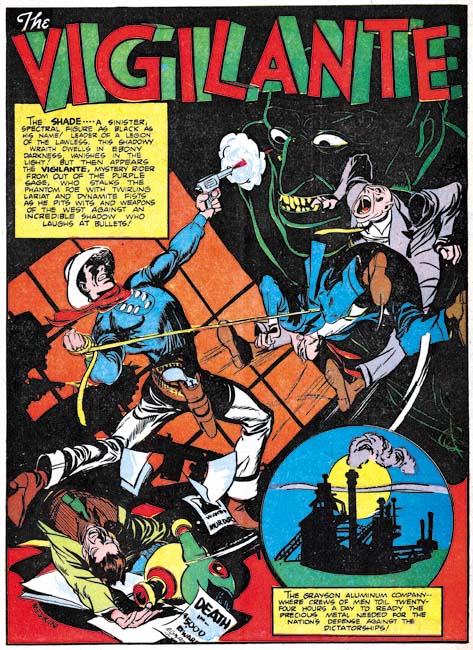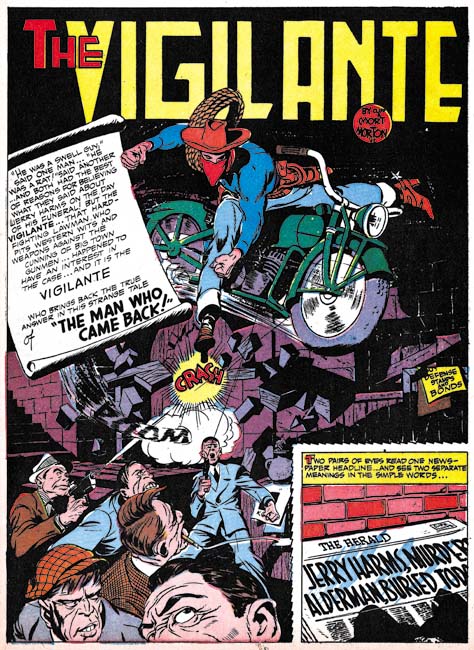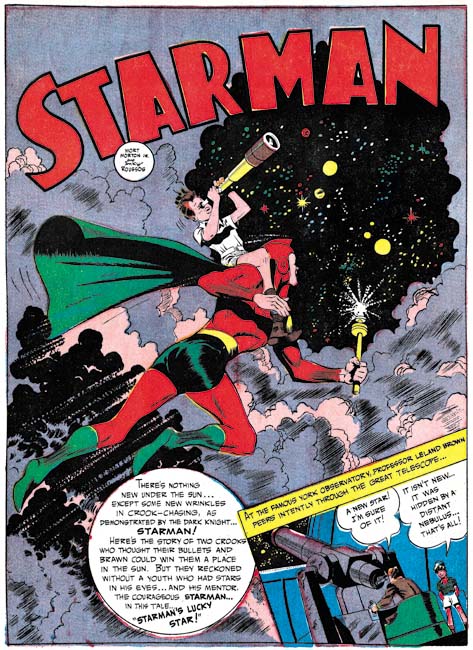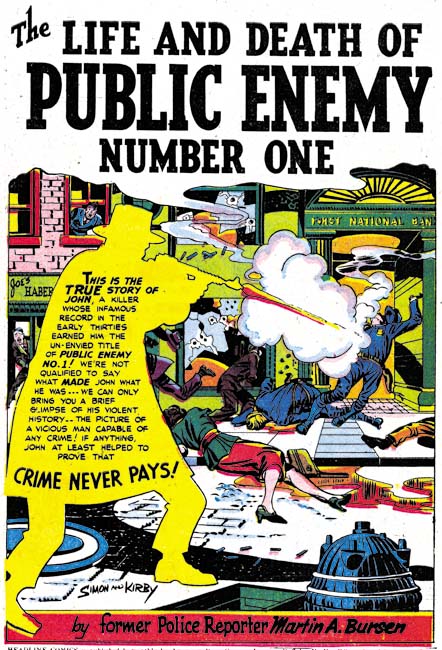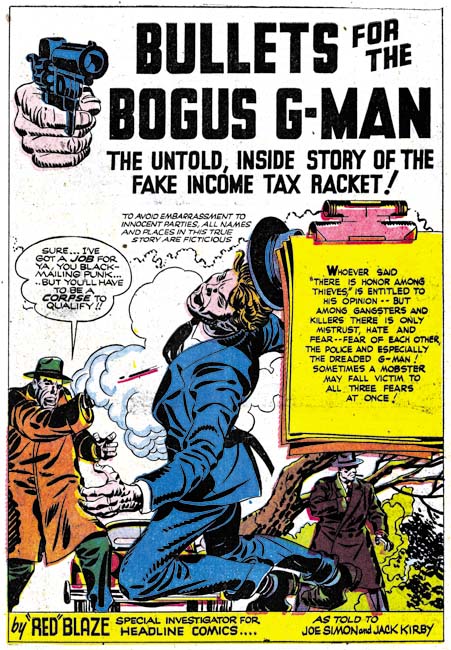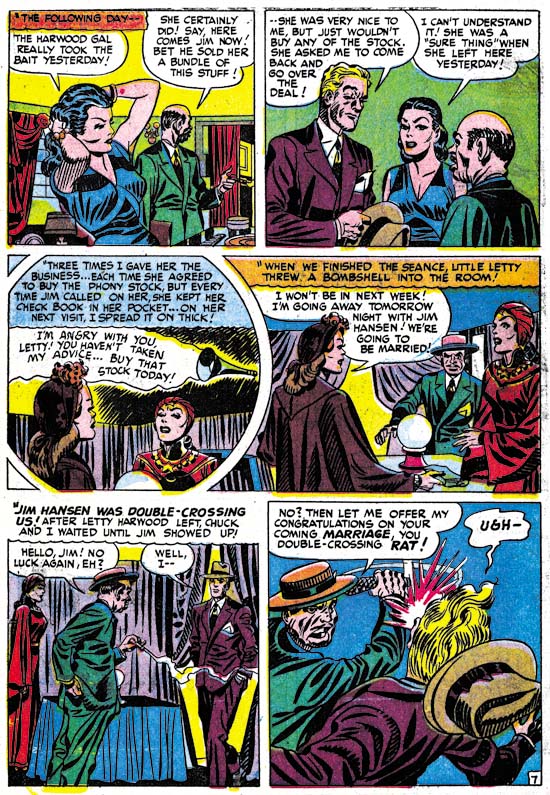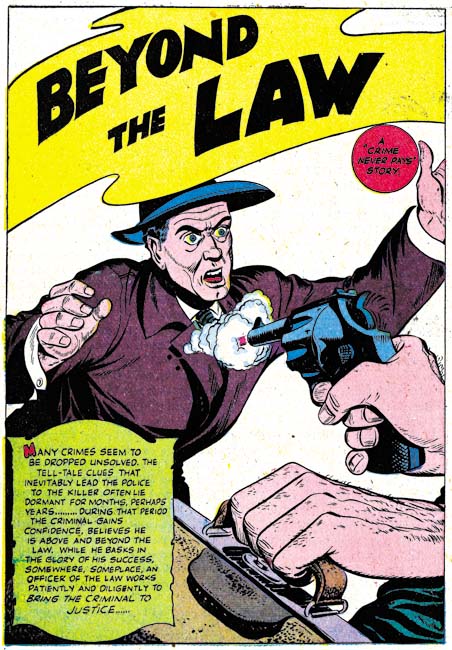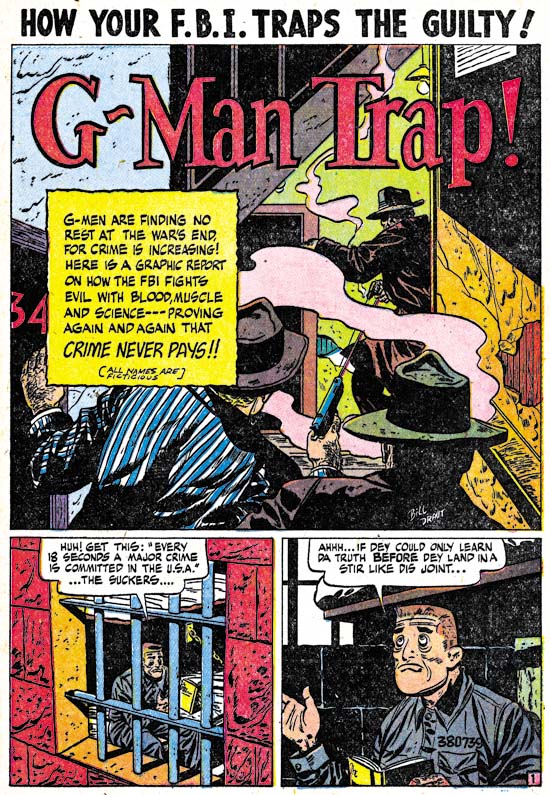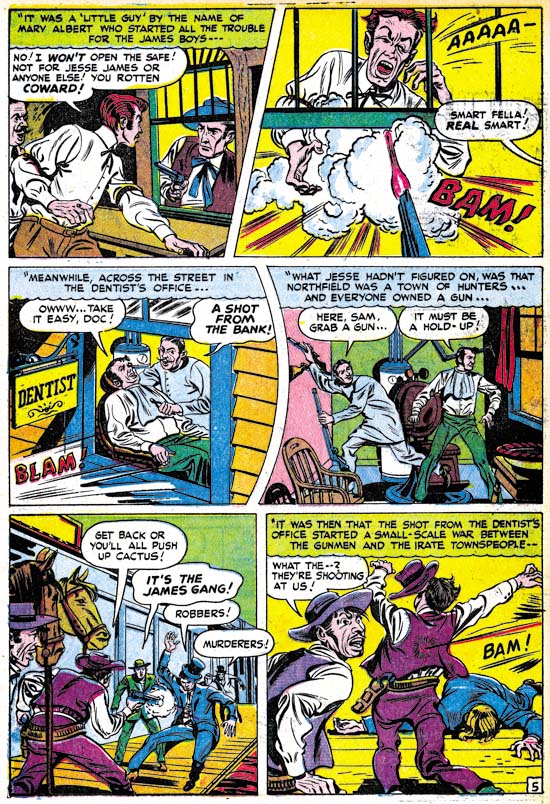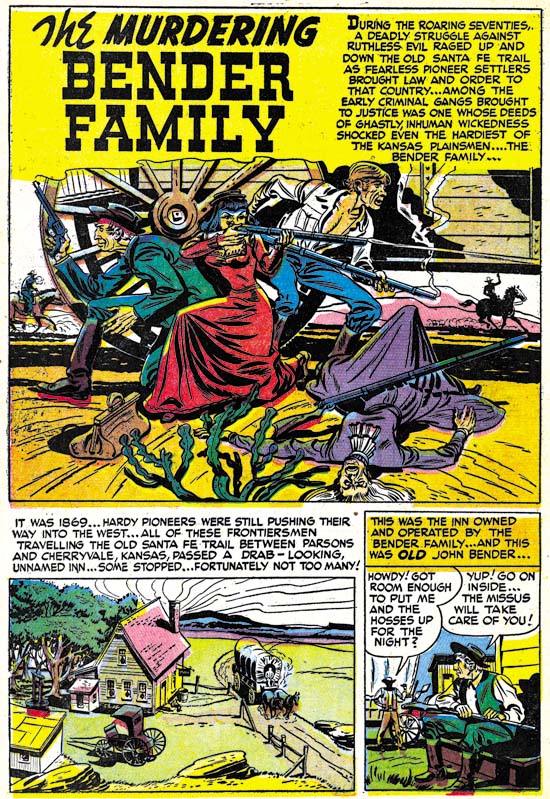Last update: 1/2/2012
Codes:
s: = signed
a: = signed with alias
&: = signed Simon and Kirby
?: = questionable attribution
r: = reprint
Action (National/DC)
42 Nov 1941 8p "The Vigilante"
s 43 Dec 1941 13p "The Vigilante"
44 Jan 1942 13p "Galloping Gold"
45 Feb 1942 13p "The Head"
s 46 Mar 1942 12p "Crimes in Color"
47 Apr 1942 12p "The Green Cowled Menace"
48 May 1942 12p "Crime's Caravan "
49 June 1942 12p "The Rainbow Man"
s 50 July 1942 12p "The Man Who Came Back"
51 Aug 1942 12p "Guns, Gold, and Glory"
52 Sept 1942 12p "Sing a Song of Six Guns"
53 Oct 1942 12p "The Blackout Blues"
54 Nov 1942 12p "The Rookie who Fought a Ghost"
55 Dec 1942 12p "Bullets for Breakfast"
s 56 Jan 1943 12p "The Man Who Came Back"
57 Feb 1943 12p "The Feud of the Rimfire Ridge"
s 58 Mar 1943 12p "The Dummy and the Dumbbell"
59 Apr 1943 12p "Fiddler's Fee"
60 May 1943 12p "Rainbow over Crimeville"
61 June 1943 12p "The Cat and the Fiddler"
62 July 1943 12p "The Crime Carnival"
63 Aug 1943 12p "Dummy, Dummy & Dummy, Inc."
64 Sept 1943 12p "The Treasure of Dead Man's Key"
65 Oct 1943 12p "The Bard of Banditry"
66 Nov 1943 10p "The Sword of Destiny"
s 67 Dec 1943 10p "The Academy of Musical Crime"
68 Jan 1944 10p "The Duke Goes to the Dogs"
69 Feb 1944 10p "The Little Men Who Were There"
a 70 Mar 1944 10p "A Challenge from the Pyramids"
71 Apr 1944 10p "Alias Mr. Sunshine"
72 May 1944 10p "The Guns of Killer Haines"
73 June 1944 10p "Dirge on a Bull Fiddle"
74 July 1944 10p "Wheels of Jeopardy"
75 Aug 1944 10p "Blunderbuss Booty"
76 Sept 1944 10p "The Mountain Without a Top"
77 Oct 1944 10p "The Rainbow Man sees Red"
78 Nov 1944 10p "Portraits for Plunder"
79 Dec 1944 10p "Birds of Ill Omen"
80 Jan 1945 10p "The Pillage of the Parthenon"
81 Feb 1945 10p "The Chinatown Kid, Magician"
82 Mar 1945 10p "Magnet for Mobsters"
83 Apr 1945 10p "A Fortune for a Fossil"
84 May 1945 10p "Three's a Crowd"
85 June 1945 5p "Old Wyoming"
a 86 July 1945 10p "Orient of the Occident"
87 Aug 1945 10p "The Dummy Art Expert"
88 Sept 1945 10p "Of Cops and Robbers"
89 Oct 1945 10p "The Curse of the Khabod Q"
a 90 Nov 1945 10p "Picayune Pilferers"
91 Dec 1945 10p "The Fiddler's Jam Session"
s 92 Jan 1946 10p "The Amazing Mr. Minute"
93 Feb 1946 10p "Way Down East"
94 Mar 1946 10p "The Escape of Elephant Al"
95 Apr 1946 10p "The Burgling Bookman"
96 May 1946 10p "Danger's Midgets"
97 June 1946 10p "Animal Master"
98 July 1946 10p "Treasure of the Ancients"
? 99 Aug 1946 10p "The Tiger's Skin"
100 Sept 1946 10p ""
? 101 Oct 1946 10p "When East Goes West"
Adventure (National/DC)
s 81 Dec 1942 10p "Starman's Lucky Star"
s 82 Jan 1943 10p "Hitch A Wagon To The Stars"
All American Men of War (National/DC)
13 Sept 1954 7p "The Three Tanks"
All For Love (Prize)
? 1 (v.1, n1) Apr 1957 6p "Hollow Triumph"
? 1 (v.1, n1) Apr 1957 1p "Take It Easy"- (text)
2 (v.1, n2) June 1957 6p "Leading Man"
2 (v.1, n2) June 1957 6p "Stay Feminine"
Battle Action (Timely/Atlas/Marvel)
24 Aug 1956 5p "No Surrender"
Black Cat Mystery (Harvey)
51 Aug 1954 5p "Punch & Rudy"
57 Jan 1956 5p "The World Of Mr. Chatt"
Black Magic (Prize)
s 1 (v.1, n1) Oct 1950 6p "The Woman In The Mirror"
1 (v.1, n1) Oct 1950 5p "His Father's Footsteps"
2 (v.1, n2) Dec 1950 7p "The Cheerful Old Lady In Black"
s 3 (v.1, n3) Feb 1951 8p "A Curse On You"
4 (v.1, n4) Apr 1951 8p "A Man's Last Dream"
s 4 (v.1, n4) Apr 1951 6p "The Dead Don't Really Die"
5 (v.1, n5) June 1951 8p "Who Walks In My Dream"
5 (v.1, n5) June 1951 9p "Sleep, Perchance To Die"
6 (v.1, n6) Aug 1951 6p "The Masterpiece"
7 (v.2, n1) Oct 1951 8p "The Man Who Captured A Ghost"
8 (v.2, n2) Dec 1951 9p "Invisible Link"
8 (v.2, n2) Dec 1951 6p "The House That Tried To Kill Me"
9 (v.2, n3) Feb 1952 4p "Faith Healer"
9 (v.2, n3) Feb 1952 5p "The Ghost Of Chateau Bois"
10 (v.2, n4) Mar 1952 3p "Memory House"
10 (v.2, n4) Mar 1952 4p "The World Beyond Reality"
10 (v.2, n4) Mar 1952 7p "The Assassin"
11 (v.2, n5) Apr 1952 5p "Drop Me Of At The Cemetery"
12 (v.2, n6) May 1952 8p "It's Your Funeral"
12 (v.2, n6) May 1952 7p "A Giant Walks The Earth"- (Kirby pencils first page, inks part)
13 (v.2, n7) June 1952 7p "A Rag, A Bone And A Hank Of Hair"- (Kirby splash)
14 (v.2, n8) July 1952 8p "Choose A Face"
15 (v.2, n9) Aug 1952 7p "The Promised Land"
17 (v.2, n11) Oct 1952 6p "Guardian Angel"
19 (v.3, n1) Dec 1952 4p "Return From The Grave"
23 (v.3, n5) Apr 1953 6p "Land Of The Dead"
31 (v.5, n1) July 1954 6p "Gargoyle"
31 (v.5, n1) July 1954 6p "The Half-Men"
32 (v.5, n2) Sept 1954 5p "The Devil Doll"
Black Magic (National/DC)
r 4 (v.1, n4) July 1974 5p "His Father's Footsteps"- (r BM #1 Oct 1950)
r 5 (v.1, n5) Sept 1974 8p "It's Your Funeral"- (r BM #12 May 1952)
r 7 (v.1, n7) Jan 1975 8p "Freak"- (r BM #17 Oct 1952)
r 9 (v.1, n9) May 1975 8p "Who Walks In My Dreams"- (r BM #5 Jun 1951)
Black Terror (Standard)
s 27 June 1949 10p "The Haunt of Kowanchoo"
Boys' Ranch (Harvey)
1 Oct 1950 2p "Introducing the Kid Cowboys"
? 1 Oct 1950 1p "Western Lore"
2 Dec 1950 1p "The Original Cowboys"
3 Feb 1951 1p "The Texas Rangers"
3 Feb 1951 6p "I'll Fight You For Lucy"
? 5 June 1951 1p "How To Ride A Horse, Lesson 5, Using the Aids"
Chamber of Chills (Harvey)
24 July 1954 5p "Credit and Loss"
Fighting Yank (Standard)
s 28 July 1949 10p "The Crucible of Crime"
s 28 July 1949 8p "Ho, For the Artist's Life"
s 29 Aug 1949 10p "Fireworks on the Fourth"
s 29 Aug 1949 4p "The Half-Horsepower Judge"
29 Aug 1949 2p "The Fighting Yank's Submarine Patrol"- (illustrated text)
s 29 Aug 1949 8p "Accidents for Sale"
Frankenstein (Prize)
20 Aug 1952 6p "The Man Who Died Twice"
21 Oct 1952 6p "Ghost of Jean Lafitte"- (text)
27 Oct 1953 6p "So Red My Roses"
29 Feb 1954 6p "Modern Achilles"
29 Feb 1954 4p "Clinging Corpse"
Golden Lad (Spark)
1 July 1945 [cover]
s 1 July 1945 9p "The Heart of Gold"
s 2 Nov 1945 [cover]
s 2 Nov 1945 9p "The Haven for All"
s 3 Feb 1946 [cover]
s 3 Feb 1946 8p "The League of 1965"
4 Apr 1946 [cover]
4 Apr 1946 [contents]
s 4 Apr 1946 11p "The Menace of the Minstrel"
s 5 June 1946 [cover]
Headline (Prize)
s 40 (v.5, n4) Mar 1950 8p "The Man Of Many Faces"
43 (v.6, n1) Sept 1950 7p "Our Swords Will Find You"
44 (v.6, n2) Nov 1950 7p "Dynamite"
45 (v.6, n3) Jan 1951 8p "City In Terror"
45 (v.6, n3) Jan 1951 7p "Name Your Assassin"
48 (v.6, n6) July 1951 7p "Leech Of The Underworld"
48 (v.6, n6) July 1951 7p "Loophole"
49 (v.7, n1) Sept 1951 8p "Come Share My Tomb"
49 (v.7, n1) Sept 1951 7p "Female Of The Species"
50 (v.7, n2) Nov 1951 7p "Cross and Double Cross"
52 (v.7, n4) Mar 1952 7p "Coffin for a Killer"
53 (v.7, n5) May 1952 7p "The Accusing Corpse"
54 (v.7, n6) July 1952 7p "Shadow of the Gallows"
55 (v.8, n1) Sept 1952 7p "Mr. Underground"
58 (v.8, n4) Mar 1953 1p "Crime Oddities"
61 (v.9, n1) Sept 1953 6p "Brain of the Underworld"
62 (v.9, n2) Nov 1953 6p "Efficiency System"
63 (v.9, n3) Jan 1954 4p "Time To Kill"
63 (v.9, n3) Jan 1954 6p "Counterfeit G-Man"
64 (v.9, n4) Mar 1954 6p "Savage Circle"
65 (v.9, n5) May 1954 6p "Appointment with Death"
66 (v.9, n6) July 1954 3p "Murder Will Out"
66 (v.9, n6) July 1954 2p "Soft Touch"
66 (v.9, n6) July 1954 6p "G-Men Are Poison"
67 (v.10, n1) Sept 1954 6p "Chain Reaction"
68 (v.10, n2) Nov 1954 6p "Road To Alcatraz"
69 (v.10, n3) Jan 1955 6p "Freezeout"
70 (v.10, n4) Mar 1955 6p "Face of Death"
70 (v.10, n4) Mar 1955 6p "Flames of Destruction"
71 (v.10, n5) May 1955 6p "The Crusader"
72 (v.10, n6) July 1955 6p "Ordeal By Fire"
72 (v.10, n6) July 1955 6p "My Beat"
s 73 (v.11, n1) Sept 1955 6p "Big Man"
74 (v.11, n2) Jan 1956 7p "Money From Nowhere"
75 (v.11, n3) Mar 1956 6p "Duke Kennedy"
75 (v.11, n3) Mar 1956 6p "The Fight Fan"
76 (v.11, n4) May 1956 6p "The Grafters"
House of Mystery (National/DC)
60 Mar 1957 6p "The Thing in the Telescope"
64 July 1957 6p "The Human Time Capsule"
66 Sept 1957 [cover]
66 Sept 1957 6p "The Girl in the Iron Mask"
70 Jan 1958 6p "The Menace of the Maze"
78 Sept 1958 6p "The 100 Lives of Napoleon Burke"
s 137 Sept 1963 8p "The Girl from Two Worlds"
House of Secrets (National/DC)
3 Mar 1957 6p "The Mystery of the Martian Menu"
4 May 1957 6p "The Amazing Visions of Abel Innes"
6 June 1957 6p "The Bewitched Costumes"
19 Apr 1959 8p "The Man Who Turned to Gold"
42 Mar 1961 8p "The Thief of Time"
52 Feb 1962 9p "The Guardian Lion-Man"
60 June 1962 [cover]
s 60 June 1962 10p "Captive of the Cat Curse"
? 62 Oct 1962 [cover]
s 62 Oct 1962 10p "The Three Faces of Fear"
s 67 Aug 1964 12p "Doctor-7's Supernatural Ally"
In Love (Mainline)
1 Sept 1954 2p "After The Honey-Moon"
Jumbo (Fiction House Magazines)
s 1 Sept 1938 5p "Sheena"
s 2 Oct 1938 4p "Sheena"
Justice Traps the Guilty (Prize)
17 (v.3, n5) Aug 1950 7p "The Statue Screams"
19 (v.4, n1) Oct 1950 7p "Deadlier Than The Male"
20 (v.4, n2) Nov 1950 8p "Curse Of Me-Meb"
20 (v.4, n2) Nov 1950 7p "Human Cargo"
s 21 (v.4, n3) Dec 1950 7p "O'Hara Had A Heart"
21 (v.4, n3) Dec 1950 7p "The Dead Can't Sleep"
22 (v.4, n4) Jan 1951 8p "Bad Medicine"
22 (v.4, n4) Jan 1951 7p "Hideout"
23 (v.4, n5) Feb 1951 8p "Prevue Of Death"
23 (v.4, n5) Feb 1951 7p "Bullets For Christmas"
24 (v.4, n6) Mar 1951 7p "A Handful of Death"
27 (v.4, n9) June 1951 7p "Houdini of the Underworld"
28 (v.4, n10) July 1951 7p "Foto Frame-Up"
29 (v.4, n11) Aug 1951 7p "Rat Hole"
30 (v.4, n12) Sept 1951 7p "Trail Of Doom"
30 (v.4, n12) Sept 1951 7p "Dead Man's Debt"
31 (v.5, n1) Oct 1951 7p "Angel Of Death"
32 (v.5, n2) Nov 1951 7p "A Very Careful Guy"
33 (v.5, n3) Dec 1951 7p "Monster On The Midway"
34 (v.5, n4) Jan 1952 7p "Dead Man's Double"
35 (v.5, n5) Feb 1952 6p "Fall Guy"
36 (v.5, n6) Mar 1952 7p "Find the Woman"
37 (v.5, n7) Apr 1952 6p "Breakout"
38 (v.5, n8) May 1952 5p "14 Carat Payoff"
39 (v.5, n9) June 1952 7p "Terror"
40 (v.5, n10) July 1952 7p "One Way to the Chair"
41 (v.5, n11) Aug 1952 8p "No Place To Hide"
s 43 (v.6, n1) Oct 1952 6p "Restless Dead"
44 (v.6, n2) Nov 1952 6p "The Hard Way"
45 (v.6, n3) Dec 1952 6p "Embezzlement"
45 (v.6, n3) Dec 1952 5p "Easy Money"
47 (v.6, n5) Feb 1953 5p "Payoff"
48 (v.6, n6) Mar 1953 6p "Web of Pain"
49 (v.6, n7) Apr 1953 5p ".38 Caliber Casanova"
53 (v.6, n11) Aug 1953 6p "Boomerang"
54 (v.6, n12) Sept 1953 5p "Fatal Mistake"
55 (v.7, n1) Oct 1953 4p "Rebound"
56 (v.7, n2) Nov 1953 5p "G-Man Payoff"
56 (v.7, n2) Nov 1953 6p "Side-Liner"
57 (v.7, n3) Dec 1953 6p "The Tri-State Terror"
58 (v.7, n4) Jan 1954 7p "Desert Justice"
58 (v.7, n4) Jan 1954 1p "Two-Gun Crowley"
60 (v.7, n5) Feb 1954 6p "Deadly Circle"
60 (v.7, n5) Feb 1954 5p "Homicide By Proxy"
61 (v.7, n7) Apr 1954 6p "Pretty Boy Floyd"
62 (v.7, n8) May 1954 6p "The Last Leap"
62 (v.7, n8) May 1954 1p "The Fall Guy"
63 (v.7, n9) June 1954 6p "Deadly Detour"
63 (v.7, n9) June 1954 5p "Big Wheel"
64 (v.7, n10) July 1954 6p "The Gentleman Farmer"
64 (v.7, n10) July 1954 6p "Double-Crosser"
65 (v.7, n11) Aug 1954 6p "One Slug Short"
65 (v.7, n11) Aug 1954 6p "Deadly Reunion"
66 (v.7, n12) Sept 1954 6p "V.I.P."
69 (v.8, n3) Dec 1954 5p "Flames Of Sabotage"
69 (v.8, n3) Dec 1954 5p "Find The Corpse"
70 (v.8, n4) Mar 1955 6p "The Fix"
72 (v.8, n6) Mar 1955 6p "The Saucer Man"
74 (v.8, n8) May 1955 6p "Frameup"
75 (v.8, n9) June 1955 2p "Jackpot"
76 (v.8, n10) July 1955 6p "Tour of Duty"
s 78 (v.8, n12) Sept 1955 6p "The Motorcycle"
s 80 (v.9, n1) Feb 1956 5p "Silent Witness"
More Fun (National/DC)
s 85 Nov 1942 8p "The Magic Formula"
s 107 Jan 1946 10p "Vacation with Double Pay"
My Greatest Adventure (National/DC)
s 57 July 1961 9p "A Beast Was My Judge"
s 70 Aug 1962 8p "I Won the Doom Castle"
Out of the Shadows (Standard)
s 14 Aug 1954 7p "Werewolf"
Pep (Archie)
s 3 Apr 1940 6p "The Press Guardian"
s 7 Aug 1940 6p "Perry Case the Press Guardian"
9 Nov 1940 6p "Press Guardian"
s 10 Dec 1940 6p "Press Guardian"
s 11 Jan 1941 6p "Press Guardian"
s 11 Jan 1941 6p "Midshipman"
s 12 Feb 1941 6p "Midshipman"
Police Trap (Mainline)
1 Sept 1954 4p "The Capture"
Police Trap (Super Comics)
r 16 **** 1964 4p "The Capture"
Prize Comics Western (Prize)
114 Nov 1955 6p "The Drifter"
s 115 Jan 1956 6p "Bad Medicine"
116 Mar 1956 6p "Lighting Draw"
s 117 May 1956 6p "Weak Boy"
117 May 1956 6p "Posse of the Border"
118 July 1956 7p "Mystery of the Calico Pony"
s 118 July 1956 6p "Thirsty Mule"
Real Fact (National/DC)
10 Sept 1947 [cover]
10 Sept 1947 6p "How a Movie Serial is Made"
Real West Romances (Prize)
s 5 Dec 1949 8p "Tenderfoot In Love"
s 6 Feb 1950 9p "Lies, Love and Hoss Liniment"
6 Feb 1950 2p "Kiss In The Moonlight"- (illustrated text)
Strange Adventures (National/DC)
168 Sept 1964 9p "I Hunted Toki the Terrible"
Strange World of Your Dreams (Prize)
1 Aug 1952 2p "You Sent Us This Dream"
1 Aug 1952 7p "The Dreaming Tower"
2 Sept 1952 7p "I Lived 200 Years Ago"
3 Nov 1952 8p "Edge Of Madness"
4 Jan 1953 7p "Show Your Face"
Tales Of The Unexpected (National/DC)
12 Apr 1957 6p "The Witch's Statues"
13 May 1957 6p "The Thing from the Skies"
13 May 1957 6p "The Thing from the Skies"
15 July 1957 6p "The City of Three Dooms"
15 July 1957 6p "The City of Three Dooms"
16 Aug 1957 6p "I Was a Spy for Them"
18 Oct 1957 6p "The Riddle of the Glass Bubble"
18 Oct 1957 6p "The Riddle of the Glass Bubble"
Tom Corbett, Space Cadet (Prize)
1 May 1955 7p "The Spaceship of Doom"
1 May 1955 8p "Octopus Tree"
1 May 1955 7p "The Spaceways of Peril"
s 2 July 1955 [cover]
2 July 1955 9p "The Outlaws of Uranus"
2 July 1955 7p "The Invaders"
2 July 1955 6p "Wolf Planet"
s 3 Sept 1955 [cover]
s 3 Sept 1955 8p "Dangerous Cargo"
s 3 Sept 1955 7p "The Drifter"
3 Sept 1955 7p "The Craters of Mercury"
Treasure (Prize)
s 10 Dec 1946 6p "Know Your America"
12 Fall 1947 6p "Know Your America"
Western Comics (National/DC)
1 Jan 1948 12p "Jesse James Rides Again"
3 May 1948 10p "Vigilante"
4 July 1948 10p "The Four Notches of Hate"
Western Love (Prize)
s 4 Jan 1950 8p "The Rancher's Daughter"
5 Mar 1950 1p "Cowboy Romeo Or City Slicker"
s 5 Mar 1950 9p "Lilly's Last Stand"
Western Tales (Harvey)
r 32 Mar 1956 6p "I'll Fight You For Lucy"
Westerner (Toytown)
s 10 Mar 1949 14p "Custer's Massacre"
Young Brides (Prize)
s 1 (v.1, n1) Sept 1952 8p "My Hero"
2 (v.1, n2) Nov 1952 7p "Wait For The Doctor"
3 (v.1, n3) Jan 1953 3p "What Advice Would You Have Given"
3 (v.1, n3) Jan 1953 8p "Bride And Broom"
3 (v.1, n3) Jan 1953 7p "Strange Honeymoon"
s 4 (v.1, n4) Mar 1953 8p "Under 21"
5 (v.1, n5) May 1953 7p "Don't Cry On My Shoulder"
7 (v.2, n1) Sept 1953 8p "Mind Your Own Marriage"
10 (v.2, n4) Dec 1953 1p "How He Proposed"
11 (v.2, n5) Jan 1954 6p "Too Beautiful To Be True"
12 (v.2, n6) Feb 1954 6p "Don't Take My Child From Me"
14 (v.2, n8) Apr 1954 6p "Faithless"
15 (v.2, n9) May 1954 7p "Husband At Large"
16 (v.2, n10) June 1954 [cover]
17 (v.2, n11) July 1954 7p "Act Of Faith"
17 (v.2, n11) July 1954 6p "Mother To All"
18 (v.2, n12) Sept 1954 6p "My Cheating Heart"
s 22 (v.3, n4) May 1955 [cover]
s 23 (v.3, n5) July 1955 [cover]
Young Love (Prize)
s 8 (v.2, n2) Apr 1950 8p "Danger, Soft Shoulder"
8 (v.2, n2) Apr 1950 1p "Which Is Your Dream Man?"
s 9 (v.2, n3) May 1950 8p "A Man In Her Room"
9 (v.2, n3) May 1950 2p "Problem Clinic"
s 10 (v.2, n4) June 1950 8p "My Backwoods Love"
s 11 (v.2, n5) July 1950 7p "Let's Try Again"
s 11 (v.2, n5) July 1950 7p "A Match For Any Man"
11 (v.2, n5) July 1950 2p "Problem Clinic"
12 (v.2, n6) Aug 1950 8p "Smooth Operator"
12 (v.2, n6) Aug 1950 2p "Problem Clinic"
s 13 (v.2, n7) Sept 1950 8p "In Trouble"
13 (v.2, n7) Sept 1950 2p "Problem Clinic"
14 (v.2, n8) Oct 1950 8p "Stay Out Of My Life"
s 14 (v.2, n8) Oct 1950 8p "Girls Like Her"
16 (v.2, n10) Dec 1950 7p "The Upstairs Maid"
16 (v.2, n10) Dec 1950 1p "When He Begins to Tire"- (text)
17 (v.2, n11) Jan 1951 8p "I Saw Him First"
17 (v.2, n11) Jan 1951 7p "I Promised Never To Marry"
18 (v.2, n12) Feb 1951 8p "Unwilling Bride"
18 (v.2, n12) Feb 1951 1p "Let's Talk Clothes"
19 (v.3, n1) Mar 1951 3p "Only Human"
19 (v.3, n1) Mar 1951 9p "Love Song In Blue"
20 (v.3, n2) Apr 1951 8p "The Cinderella Girl"
20 (v.3, n2) Apr 1951 8p "Love Parasite"
20 (v.3, n2) Apr 1951 3p "Will You Help Me"
s 21 (v.3, n3) May 1951 9p "Get Rid Of That Woman"
21 (v.3, n3) May 1951 8p "Second Try"
22 (v.3, n4) June 1951 10p "Meet The Folks"
22 (v.3, n4) June 1951 1p "There's Romance In The Stars"
22 (v.3, n4) June 1951 9p "The Breakup"
23 (v.3, n5) July 1951 9p "Maid To Order"
24 (v.3, n6) Aug 1951 3p "If Your Thinking Of Eloping"
24 (v.3, n6) Aug 1951 8p "Native Wedding"
25 (v.3, n7) Sept 1951 3p "Problem Clinic"
25 (v.3, n7) Sept 1951 9p "Marriage Bargain"
s 26 (v.3, n8) Oct 1951 8p "Let's Keep It Gay"
26 (v.3, n8) Oct 1951 2p "Problem Clinic"
27 (v.3, n9) Nov 1951 8p "The Brush Off"
27 (v.3, n9) Nov 1951 3p "Problem Clinic"
s 27 (v.3, n9) Nov 1951 9p "Fresh As Daisy"
s 28 (v.3, n10) Dec 1951 8p "The Pest"
28 (v.3, n10) Dec 1951 3p "Problem Clinic"
s 28 (v.3, n10) Dec 1951 8p "The Other Woman"
29 (v.3, n11) Jan 1952 8p "Love 'Em And Leave 'Em Guy"
29 (v.3, n11) Jan 1952 5p "The Sensible Thing To Do"
29 (v.3, n11) Jan 1952 2p "Problem Clinic"
30 (v.3, n12) Feb 1952 1p "The Way They Met"
30 (v.3, n12) Feb 1952 6p "Mel-Vin"
30 (v.3, n12) Feb 1952 8p "Tired Of Her"
31 (v.4, n1) Mar 1952 6p "Razzle Dazzle Romance"
31 (v.4, n1) Mar 1952 8p "Baby Doll"
32 (v.4, n2) Apr 1952 9p "Love or Goulash"
32 (v.4, n2) Apr 1952 2p "Problem Clinic"
32 (v.4, n2) Apr 1952 9p "His Lucky Number"
33 (v.4, n3) May 1952 7p "Under My Skin"
34 (v.4, n4) June 1952 6p "Live It Up"
s 35 (v.4, n5) July 1952 5p "Mind Your Manners"
35 (v.4, n5) July 1952 3p "Problem Clinic"
36 (v.4, n6) Aug 1952 8p "Mister Fix-It"
36 (v.4, n6) Aug 1952 2p "What Advice Would You Have Given"
36 (v.4, n6) Aug 1952 7p "Man Of Mystery"
s 38 (v.4, n8) Oct 1952 8p "Take Care Of My Sweetheart"
38 (v.4, n8) Oct 1952 2p "Problem Clinic"
39 (v.4, n9) Nov 1952 7p "Marriage On The Rocks"
39 (v.4, n9) Nov 1952 6p "Lovers Quarrel"
40 (v.4, n10) Dec 1952 2p "Problem Clinic"
s 41 (v.4, n11) Jan 1953 8p "Forget Me, Fraulein"- (with Kirby touchups)
s 42 (v.4, n12) Feb 1953 8p "Scarlet Sister"
51 (v.5, n9) Nov 1953 2p "What Advice Would You Have Given"
52 (v.5, n10) Dec 1953 6p "Loving Sister"
56 (v.6, n2) Apr 1954 [cover]
56 (v.6, n2) Apr 1954 6p "I'll Buy Your Love"
s 56 (v.6, n2) Apr 1954 6p "Lola's Other Life"
57 (v.6, n3) May 1954 7p "Another Woman's Baby"
57 (v.6, n3) May 1954 8p "Beaten Woman"
58 (v.6, n4) June 1954 6p "Live, Love And Be Married"
59 (v.6, n5) July 1954 6p "Little Miss Know-It-All"
60 (v.6, n6) Aug 1954 6p "Outcast"
61 (v.6, n7) Sept 1954 6p "Tragedy For Three"
s 65 (v.6, n11) June 1955 [cover]
s 66 (v.6, n12) Aug 1955 [cover]
s 67 (v.7, n1) Oct 1955 [cover]
s 67 (v.7, n1) Oct 1955 6p "Change Of Heart"
s 68 (v.7, n2) Dec 1955 [cover]
s 68 (v.7, n2) Dec 1955 6p "No One To Marry"
Young Romance (Prize)
s 16 (v.3, n4) Dec 1949 7p "His Engagement Ring"
s 18 (v.3, n6) Feb 1950 8p "I Own This Man"
19 (v.3, n7) Mar 1950 1p "The Beauty Clinic"- (illustrated text)
s 19 (v.3, n7) Mar 1950 8p "The Fisherman's Daughter"
20 (v.3, n8) Apr 1950 1p "Do You Know Your Wolves"
20 (v.3, n8) Apr 1950 1p "That Well-Dressed Look"- (illustrated text)
s 20 (v.3, n8) Apr 1950 6p "The Prophecy"
s 21 (v.3, n9) May 1950 8p "The Woman Who Lost Him"
s 22 (v.3, n10) June 1950 8p "Child Bride"
24 (v.3, n12) Aug 1950 2p "Problem Clinic"
24 (v.3, n12) Aug 1950 1p "The Little Things Remind Him Of You"
24 (v.3, n12) Aug 1950 1p "Danger, Man Trap"
s 24 (v.3, n12) Aug 1950 8p "Take A Chance"
25 (v.4, n1) Sept 1950 1p "Are You A Gold Digger"
25 (v.4, n1) Sept 1950 2p "Problem Clinic"
26 (v.4, n2) Oct 1950 2p "Problem Clinic"
26 (v.4, n2) Oct 1950 1p "Do Something Nice For Your Sweetheart"
27 (v.4, n3) Nov 1950 8p "Chase Me Till I Catch You"
s 28 (v.4, n4) Dec 1950 7p "His Father's Son"
29 (v.4, n5) Jan 1951 7p "Diagnosis: Love"
s 29 (v.4, n5) Jan 1951 8p "Three's A Crowd"
30 (v.4, n6) Feb 1951 9p "My Lord And Master"
31 (v.4, n7) Mar 1951 3p "Will You Help Me"
31 (v.4, n7) Mar 1951 6p "My Last Blind Date"
32 (v.4, n8) Apr 1951 8p "Painted Woman"
s 33 (v.4, n9) May 1951 8p "Take A Letter, Darling"
34 (v.4, n10) June 1951 3p "Will You Help Me"
34 (v.4, n10) June 1951 7p "Girl Friday"
35 (v.4, n11) July 1951 7p "The Man Who Loves Shabby Sally"
35 (v.4, n11) July 1951 9p "The Catskill Man-Chasers"
36 (v.4, n12) Aug 1951 2p "Problem Clinic"
36 (v.4, n12) Aug 1951 7p "Big Brother Blues"
37 (v.5, n1) Sept 1951 9p "Just To Be Near Him"
37 (v.5, n1) Sept 1951 3p "Problem Clinic"
38 (v.5, n2) Oct 1951 7p "His Dancing Teacher"
38 (v.5, n2) Oct 1951 3p "Problem Clinic"
39 (v.5, n3) Nov 1951 3p "Problem Clinic"
39 (v.5, n3) Nov 1951 5p "Marvin's Pearl"
39 (v.5, n3) Nov 1951 1p "The Way They Met"
s 40 (v.5, n4) Dec 1951 7p "The Red Dress"
41 (v.5, n5) Jan 1952 3p "Problem Clinic"
41 (v.5, n5) Jan 1952 2p "What Advice Would You Have Given"
41 (v.5, n5) Jan 1952 7p "Kill Her With Kindness"
42 (v.5, n6) Feb 1952 1p "The Way They Met"
42 (v.5, n6) Feb 1952 7p "The Green-Eyed Monster"
42 (v.5, n6) Feb 1952 8p "Marion's Husband"
42 (v.5, n6) Feb 1952 2p "What Advice Would You Have Given"
43 (v.5, n7) Mar 1952 3p "Problem Clinic"
43 (v.5, n7) Mar 1952 7p "Say It With Kisses"
43 (v.5, n7) Mar 1952 9p "Gentlemen Prefer Ladies"
44 (v.5, n8) Apr 1952 10p "A Bride for Father"
44 (v.5, n8) Apr 1952 9p "The Lady Says She's Innocent"
45 (v.5, n9) May 1952 8p "By Appointment Only"
s 45 (v.5, n9) May 1952 8p "Treat 'Em Rough"
46 (v.5, n10) June 1952 6p "The Gal On The Flying Trapeze"
46 (v.5, n10) June 1952 7p "Little Busybody"
s 47 (v.5, n11) July 1952 7p "Love Me, Love My Dog"
47 (v.5, n11) July 1952 2p "What Advice Would You Have Given"
48 (v.5, n12) Aug 1952 7p "No Greater Love"
49 (v.6, n1) Sept 1952 1p "The Way They Met"
s 50 (v.6, n2) Oct 1952 8p "A Way With The Ladies"
51 (v.6, n3) Nov 1952 6p "Good Girl, Bad Girl"
51 (v.6, n3) Nov 1952 6p "Partners"
52 (v.6, n4) Dec 1952 8p "Ne'er Do Well"
52 (v.6, n4) Dec 1952 8p "Give Up Your Baby"
53 (v.6, n5) Jan 1953 1p "Problem Clinic"
s 54 (v.6, n6) Feb 1953 7p "Poison Pen"
55 (v.6, n7) Mar 1953 8p "Afraid To Go Home"
58 (v.6, n10) June 1953 6p "Too Good For Me"
59 (v.6, n11) July 1953 5p "You Stole My Girl"
60 (v.6, n12) Aug 1953 2p "How Did You Meet Him"
62 (v.7, n2) Oct 1953 6p "Teen-Age Wildcat"
63 (v.7, n3) Nov 1953 1p "How He Proposed"
63 (v.7, n3) Nov 1953 2p "What Advice Would You Have Given"
68 (v.7, n8) Apr 1954 6p "Brotherly Love"
68 (v.7, n8) Apr 1954 6p "The Man I Couldn't Have"
71 (v.7, n11) July 1954 6p "Only Love Endures"
71 (v.7, n11) July 1954 6p "Forsaking All Others"


